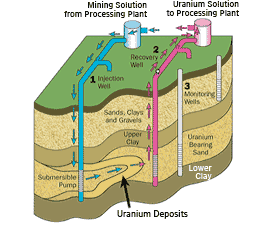First used in Wyoming in the 1950s, in-situ leaching (ISL) mining accounts for most uranium production in the United States.
In situ leaching – what it is
ISL involves injecting chemicals, called “lixivants” into an aquifer that contains a uranium ore body (i.e. deposit). The chemicals used are typically sulfuric acid or ammonium carbonate.
Under natural conditions, these ore bodies are localized and the radiation and heavy metals associated with them remain confined in small portions of an aquifer. Because under natural conditions the toxic substances associated with uranium ore bodies are locally confined, their host aquifers can be – and often are – used as drinking water sources.
When lixiviant is injected into an aquifer, it creates a chemical reaction with the uranium, causing it to spread over large areas of an aquifer. The uranium plume is brought to the surface with a series of “production wells” and processed for shipment to enrichment facilities.
In the US the production life of a well field is roughly 1 to 3 years 1. However, groundwater restoration efforts can last for decades.
Permitting and regulation
In situ recovery process.
Image: Nuclear Regulatory Commission
ISL operations are permitted and regulated by the Nuclear Regulatory Commission (NRC) or through agreement with states.
The NRC currently regulates ISL operations in Wyoming, Nebraska, and New Mexico.
In all cases, ISL uranium mines must obtain –
- an aquifer “exemption” permit to degrade the quality of groundwater resources, and
- an underground injection control permit from a state regulatory agency or the EPA in order to pollute the groundwater during the mining operation.
Exempted aquifers are exempted from the Safe Drinking Water Act and cannot be used as a future underground source of drinking water.
Regulation of ISL operations has proven problematic.
Environmental pollution from ISL: inevitable
The primary problem with ISL regulation: the NRC acknowledges that, although ISL permits require complete restoration of groundwater conditions after mining operations, some of the “baseline parameters” have proved to be unachievable by mining companies.
While the uranium mining industry insists that ISL mining methods are environmentally safe, numerous fines and violations by regulatory agencies have shown just how problematic ISL operations can be.
The increase in ISL environmental violations in recent years has led many states to relax environmental standards rather than impose stricter regulations against the mining companies.
Of the 8 currently operating ISL operations in the United States, only one has not had any reported environmental violations (Alta Mesa, Texas). Most ISL projects have had numerous spills, contaminated underground aquifers, and have failed to reclaim non-operating on site wells.
Proposed Regulation
The mining industry has never fully cleaned up an aquifer polluted by ISL. So, for the first time in 20 years, the Environmental Protection Agency now considers adopting new water quality protection standards from ISL operations: “Health and Environmental Protection Standards for Uranium and Thorium Mill Tailings” (40 CFR 192).
These new proposals require:
- Testing: Baseline characterization of aquifer geochemistry before ISL recovery begins. This baseline study is essential so we can know whether ISL polluted the aquifer or something else.
- Restoration: They also establish important restoration standards requiring compliance with the Safe Drinking Water Act (SDWA), the Resource Conservation and Recovery Act (RCRA), or Uranium Mill Tailings Control and Radiation Act (UMTRCA) whichever is most protective.
- Chemicals: The baseline and restoration tests include 13 chemicals most important 13 ground water pollution- arsenic, barium, cadmium, chromium, lead, mercury, selenium, silver, nitrate (as nitrogen), molybdenum, radium, total uranium and gross alpha particle activity.
If the ISL cannot meet these restoration standards, EPA will negotiate Alternative Concentration Limits (ACLs).
- Monitoring: The proposed rule would require ISR operators to monitor ground water for 30 years improves chances of detecting whether lixiviant escapes the polluted aquifer in to nearby underground sources of drinking water. These chemical escapes, called excursions, can mobilize other pollutants like arsenic and lead to migrate toward other aquifers
Unfortunately, EPA also proposes allowing ISL companies to perform computer models instead of continuous monitoring. Computer simulations are no substitute for monitoring. Thus, EPA should continue to require monitoring until the aquifer is restored to pre-existing standards. Neither the 30-year window nor the reliance on computer modeling should supersede monitoring.

